
The western conifer seed bug, sometimes abbreviated as WCSB, is a species of true bug (Hemiptera) in the family Coreidae. It is native to North America west of the Rocky Mountains but has in recent times expanded its range to eastern North America, to include Ontario, New Brunswick, Nova Scotia, Maine, Pennsylvania, New York, Connecticut, Massachusetts, and New Hampshire, and has become an accidental introduced species in parts of Europe and Argentina.
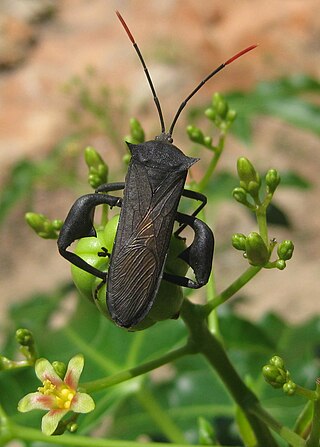
Coreidae is a large family of predominantly sap-sucking insects in the Hemipteran suborder Heteroptera. The name "Coreidae" derives from the genus Coreus, which derives from the Ancient Greek κόρις (kóris) meaning bedbug.
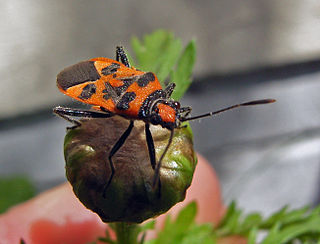
Coreoidea is a superfamily of true bugs in the infraorder Pentatomomorpha which includes leaf-footed bugs and allies. There are more than 3,300 described species in Coreoidea.

Leptoglossus oppositus a species of leaf-footed bug found in North America. It resembles Leptoglossus fulvicornis but can be distinguished by the deeper scallops in the leaf-like feature of the hind tibia and the addition of three white spots across the hemelytra. This species is widely dispersed from New York to Florida and as far west as Iowa and Minnesota, as well as the southwest regions of the United States into Mexico.

Anisoscelini is a tribe of leaf-footed bugs in the family Coreidae. It was formerly spelled Anisoscelidini, but the tribal name spelling was incorrectly formed.
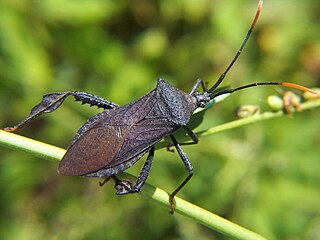
Acanthocephala is a New World genus of true bugs in the family Coreidae. The name is derived from the Greek akanth- meaning "thorn/spine" + kephale meaning "head" This name is in reference to the spine on the front of the head.

Dalader is the type genus of coreid bugs in the Daladerini tribe. Species in the genus are distributed in tropical Asia, chiefly Southeast Asia. The genus name is derived from the Sanskrit roots dal meaning leaf and dhru which means bearer. This plant bug genus is distinguished by the which preterminal antennal segment being flattened, pear-shaped, and ridged and the terminal segment being paler. Chalcidoid egg parasites have been recorded from this species. Adults of Dalader acuticosta are fried and eaten in northeastern India.
Merocoris curtatus is a species of leaf-footed bug in the family Coreidae. It is found in North America.

Eubule is a genus of leaf-footed bugs in the family Coreidae. There are about 13 described species in Eubule.
Merocoris is a genus of leaf-footed bugs in the family Coreidae. There are about eight described species in Merocoris.

Acanthocephalini is a tribe of leaf-footed bugs in the family Coreidae. There are at least 100 described species in Acanthocephalini found in the Americas.
Nisoscolopocerus is a genus of leaf-footed bugs in the family Coreidae. There are at least two described species in Nisoscolopocerus.

Ceraleptus is a genus of leaf-footed bugs in the family Coreidae. There are about nine described species in Ceraleptus.

Scolopocerus is a genus of leaf-footed bugs in the family Coreidae. There are at least four described species in Scolopocerus.

Anisoscelis is a genus of leaf-footed bugs in the family Coreidae. There are about 11 described species in the genus Anisoscelis.
Acanthocerus is a genus of leaf-footed bugs in the family Coreidae. There are at least three described species in Acanthocerus.

Cimolus is a genus of leaf-footed bugs in the family Coreidae. There are at least four described species in Cimolus.
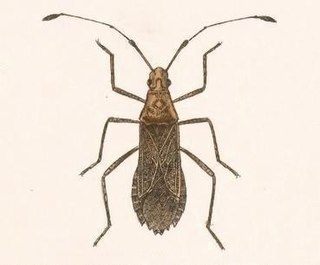
Madura is a genus of leaf-footed bugs in the family Coreidae. There are at least three described species in Madura.
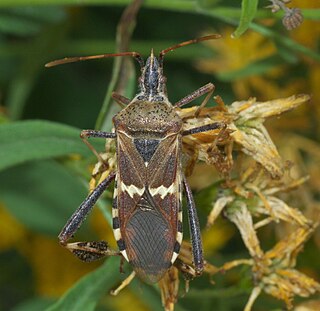
Leptoglossus clypealis, the western leaf-footed bug, is a species of leaf-footed bug in the family Coreidae. It is found in Central America and North America. In the 1980s, Hasan Bolkan discovered that the leaf-footed bug was a cause of lesions on commercially produced pistachio crops.

Homoeocerus is a genus of leaf-footed bug in the family Coreidae. There are more than 120 described species in Homoeocerus, found in south and east Asia, and Sub-Saharan Africa.

















